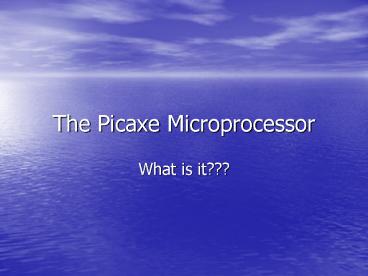The Picaxe Microprocessor - PowerPoint PPT Presentation
1 / 33
Title:
The Picaxe Microprocessor
Description:
The Picaxe Microprocessor What is it??? Well, first a large company called Microchip Technology inc. created a Programmable Interface Controller (PIC). – PowerPoint PPT presentation
Number of Views:38
Avg rating:3.0/5.0
Title: The Picaxe Microprocessor
1
The Picaxe Microprocessor
- What is it???
2
- Well, first a large company called Microchip
Technology inc. created a Programmable Interface
Controller (PIC). A pic is essentially a computer
built into a single chip. - This PIC was designed to be used in thousands of
products such as televisions, calculators,
microwaves, computers, watches, dish washers,
washing machines, telephones, and so on - Millions of pics were and are being made.
3
- But the limitation of the blank pic was that it
had to be programmed by skilled engineers in a
difficult to understand language. Also, an
expensive programmer was required to program each
chip. - For a company designing consumer electronics,
this was not too much of a hindrance as only one
complex program had to be written per batch of
electronic goods, and only one programmer could
program thousands of chips on a production line.
4
- Then along came Revolution Education, a UK
company, funded by gas and oil giants. - Revolution Education wrote a program that could
be called an operating system, just like Windows
on your PC. - This made the pic much easier to program.
Revolution Education also created an easy to use
programming editor, which used the programming
language known as Basic to program the pic.
5
- Now students can program the Picaxe processor
very easily, and use it for many applications
such as
6
- Controlling hobby servos to make things move/walk
7
- Controlling single digits
8
- Controlling multiple digits
9
- Controlling motors
10
- Sensing light levels
11
- Displaying info on LCD screens
12
- Model washing machines
13
- Range sensors (distance)
14
- Temperature sensors
15
- Speech modules
16
- Robot arms
17
- Even colour sensors
18
- And the internet
19
- Micro-switches and motors
20
- Data logging boards
21
- Infra-Red remote controls
22
- See excel for product comparison
23
- We have been working on an ASISTM grant with 5
secondary schools. - La Trobe Secondary, Diamond Valley College, Lalor
North Secondary, Peter Lalor Secondary, and
Essendon Keilor College. - As part of the grant, students start out with a
universal project board The UniBoard - After building and programming the UniBoard,
students are then open to build and design their
own unique projects. - These projects can be ANYTHING to do with
electronics, mechatronics, Picaxe chips and
science!!
24
- One such project could be
- Releasing a Picaxe powered weather balloon to the
stratosphere
25
- The onboard picaxe could log the temperature,
light level, atmospheric pressure, humidity. - It could also control a camera to take photos of
Melbourne
26
(No Transcript)
27
- Other projects could be
- A giant LED clock/thermometer just like the Nylex
clock in the city - An external weather monitor
- An alarm system
- The list goes on
28
- Now it is your turn to program the picaxe
processor - We will start off by blinking a few LEDs.
- You will see the UniBoard in front of you. There
are three onboard LEDS. Red, Yellow and Green. - Each LED is connected to an output pin.
- Red pin 0
- Yellow pin 1
- Green pin 2
29
- We can use the high and low commands to turn
the LEDs on and off. - See what this program does
- Main
- High 1
- Pause 1000
- Low 1
- Pause 1000
- Goto main
30
- Now lets use the play command to play a tune
- Main
- Play 0,1
- Pause 1000
- Goto main
31
- Now lets write a program for a stop light
- Remember
- red 0
- Yellow 1
- Green 2
32
- Main
- High 0
- Wait 30
- Low 0
- High 2
- Wait 30
- Low 2
- High 1
- Wait 3
- low 1
- Goto main
33
- Thank you!
- More info is at
- www.apmp.com.au































